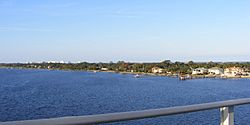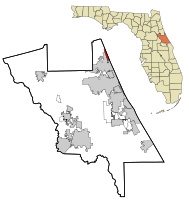Ormond-by-the-Sea, Florida facts for kids
Quick facts for kids
Ormond-by-the-Sea, Florida
|
|
|---|---|

Skyline of Ormond-by-the-Sea
|
|

Location in Volusia County and the state of Florida
|
|
| Country | |
| State | |
| County | Volusia |
| Area | |
| • Total | 2.02 sq mi (5.23 km2) |
| • Land | 2.02 sq mi (5.22 km2) |
| • Water | 0.00 sq mi (0.01 km2) |
| Elevation | 13 ft (4 m) |
| Population
(2020)
|
|
| • Total | 7,312 |
| • Density | 3,626.98/sq mi (1,400.49/km2) |
| Time zone | UTC-5 (Eastern (EST)) |
| • Summer (DST) | UTC-4 (EDT) |
| FIPS code | 12-53200 |
| GNIS feature ID | 0288246 |
Ormond-by-the-Sea is a beautiful coastal community in Florida, United States. It's not a city, but a special kind of town called a census-designated place (CDP). This means it's a place where many people live, but it doesn't have its own city government.
In 2020, about 7,312 people lived in Ormond-by-the-Sea. It's a popular spot because it's right next to the Atlantic Ocean.
Contents
Where is Ormond-by-the-Sea?
Ormond-by-the-Sea is located in Volusia County, Florida. You can find it at these coordinates: 29°20′21″N 81°3′57″W / 29.33917°N 81.06583°W.
The area is quite small, covering about 5.2 square kilometers (or 2 square miles). Most of this area is land, with only a tiny bit of water.
Boundaries and Roads
Ormond-by-the-Sea has clear boundaries:
- To the north, it touches the line between Volusia and Flagler counties.
- To the south, it borders the city of Ormond Beach.
- To the east, you'll find the vast Atlantic Ocean.
- To the west, it's next to the Halifax River.
This area is sometimes called the "North Peninsula" because it's a strip of land between the ocean and the river. You might also hear people call it "OBC" or "OBTS."
Two main roads run through the community:
- State Road A1A, also known as Ocean Shore Boulevard, runs right along the Atlantic Ocean.
- John Anderson Drive runs along the Halifax River.
Who Lives in Ormond-by-the-Sea?
| Historical population | |||
|---|---|---|---|
| Census | Pop. | %± | |
| 2000 | 8,430 | — | |
| 2010 | 7,406 | −12.1% | |
| 2020 | 7,312 | −1.3% | |
| U.S. Decennial Census | |||
In 2020, there were 7,312 people living in Ormond-by-the-Sea. This was a small decrease from the 7,406 people who lived there in 2010.
In 2000, the average household had about two people living in it. Many people living in Ormond-by-the-Sea are 65 years old or older, making it a popular place for retirement.
History and Famous Spots
The first people known to live in the Ormond-by-the-Sea area were the Timucuan Indians. In the 1500s, they had a large village called Nocoroco near what is now Tomoka State Park. The Timucuan people ate a lot of oysters and other shellfish. You can still find their old shell piles, called "middens," near the Halifax River.
Early Settlers and Plantations
One of the first European settlers was Chauncey A. Bacon. He was an architect and a veteran of the Civil War. In 1876, he bought a large piece of land and called it the Number Nine Plantation.
The Bacons first lived in a simple cabin. Later, they built a two-story house with a big fireplace made of coquina rock. This house is still standing today on John Anderson Drive. They even used wood from a shipwreck to build part of it!
The plantation also had a large fruit grove with oranges, grapefruits, and other fruits. The Bacons became known for selling "Number 9 Guava Jelly."
In 1911, Ferdinand Nordman Jr. bought the plantation. He made the fruit business even bigger, selling fruit preserves by mail all over the country. This business lasted until 1968.
Another early settler was Leonard B. Knox, who started a citrus farm called Mound Grove. His son, Donald, planted the tall Canary Island date palms that you can still see along High Bridge Road. Part of this property was once a popular fishing spot called Uncle Guy's Fish Camp.
Growth and Landmarks
For a long time, most of Ormond-by-the-Sea was undeveloped. But in the 1950s, it started to grow quickly, especially as a place for people to retire. The name "by-the-Sea" was added to show it was different from the nearby city of Ormond Beach.
One famous landmark was the Ormond Pier. It was a 750-foot-long steel structure built in 1959. Sadly, a big storm in 1984 damaged it, and the rest was taken down in the early 1990s for safety.
About a mile north on A1A, you can find an old watch tower. It was built in 1942 by the Coast Guard Reserve during World War II. Its job was to look out for German submarines off the coast. The tower was fixed up in 2004 and is one of the last towers like it on the Florida coast.
At the very north end of Ormond-by-the-Sea is the North Peninsula State Park. This park protects about 800 acres of coastal dunes and marsh lands. It's a very important home for many animals, including the Florida scrub jay. This bird is a threatened species, meaning there are not many left in the wild.
Nature and Wildlife
Even though Ormond-by-the-Sea is narrow, it has many different types of natural areas, called "ecological zones."
Beach and Dunes
The beach itself, or tidal zone, has unique reddish sand. This sand comes from crushed coquina shells. Here, you might spot sand fleas and ghost crabs. Many coastal birds like plovers, terns, and gulls also visit the beach.
Just above the water line, several types of sea turtles lay their eggs. These include the leatherback, Atlantic loggerhead, and green turtle.
Right behind the beach are the Temperate Beach Dunes. This is where plants like sea oats, beach morning glory, and beach sunflowers grow. These plants are important because their roots help hold the sand in place.
Coastal Shrubs and Forests
A little further inland is the Coastal Strand. This is a shrubby area with plants like saw palmetto, Spanish bayonet, prickly pear cactus, and greenbrier vines. This area often mixes with sand ridges that have Florida scrub plants. You might see scrub live oaks, slash pine, and Florida's state tree, the sabal palm (also called a "cabbage palm").
Animals like the Florida scrub jay and the endangered gopher tortoise live in these scrub areas.
Closer to the Halifax River, the soil is wetter. Here, you'll find Maritime Hammock species like live oaks, magnolias, and red cedars. Unfortunately, you might also see Brazilian pepper trees, which are an invasive plant that can harm the native plants.
River's Edge
The edge of the river has many plants that like wet, salty areas, such as salt marsh cordgrass and mangroves. The shallow waters are home to oysters and blue crabs. You can also see many wading birds like egrets and herons looking for food.
See also
 In Spanish: Ormond-by-the-Sea para niños
In Spanish: Ormond-by-the-Sea para niños


